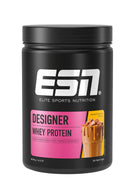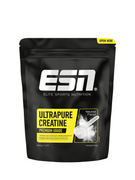
Der Ektomorph - Muskelaufbau unter erschwerten Umständen
Der erste und zugleich markanteste unter den drei grundlegenden Stoffwechseltypen ist der ektomorphe Körpertyp, der vergleichsweise leicht zu erkennen ist, da es sich bei den betreffenden Personen in der Regel, aber nicht immer, um große und vergleichsweise dünne Menschen handelt. Kennzeichnend für einen ektomorph ausfallenden Stoffwechseltyp ist neben einem kurzen Oberkörper mit schmalen Schultern das Vorhandensein langer Arme und Beine mit jeweils tendenziell zierlichen Händen und Füßen. Der Länge der Gliedmaßen entsprechend gestaltet sich die daran ansetzende Muskulatur gezwungenermaßen länglich. Da sich das Volumen der Muskulatur somit auf eine relativ große Oberfläche verteilt, dauert es oftmals lange, bis Massezuwächse beim ektomorphen Körpertyp signifikant zutage treten, so dass es mitunter vorkommt, dass eine solche Person trotz hartem Training und dementsprechender Kraftzuwächse wenig muskulös erscheint. Andererseits verfügt ein ektomorpher Stoffwechseltyp über einen sehr geringen Körperfettanteil, der auf eine deutlich erhöhte Stoffwechselgeschwindigkeit zurückzuführen ist. Den im Trainings-Jargon "Hardgainer" genannten Personen fällt es aufgrund der ineffizienten Energie- und Nährstoffverwertung ihres Organismus dementsprechend extrem schwer Muskulatur aufzubauen. Will ein Athlet mit diesen speziellen genetischen Voraussetzungen also einen massiven Körper aufbauen, benötigt er dazu deutlich mehr Kalorien als ein Sportler mit einem mesomorphen oder einem endomorphen Körpertyp.
Muskelaufbau mit angezogener Handbremse
Im Gegenzug besteht der Vorteil des sogenannten Hardgainers jedoch darin, dass er selbst in einer ausgedehnten Massephase keinen Gedanken daran verschwenden muss, eventuell an Körperfett zuzulegen. Menschen mit einem solchen Stoffwechseltyp unterscheiden sich zudem hinsichtlich der Muskelfaserzusammensetzung von Athleten, deren Körperbau eher endo- oder mesomorph ist. Im Klartext bedeutet dies, dass sie über eine signifikant höhere Anzahl an Muskelfasern des Typs 1 verfügen, die auch als Slow-Twitch oder rote Muskelfasern bekannt sind. Dies hat direkte Auswirkungen auf das Training, da dieser dominierende Muskelfasertyp unter anderem aufgrund seiner überdurchschnittlichen Sauerstoffversorgung für Ausdauerleistungen prädestiniert ist. Da die betreffenden Athleten, was ihre Genetik angeht, also nicht mit den optimalen Voraussetzungen für den Muskelaufbau ausgestattet sind, liegt der Schlüssel zum Erfolg in erster Linie im Training begründet. Angesichts der vergleichsweise geringen Anzahl an Muskelfaserns des Typs 2 dauert es recht lange, bis sich das Kraftniveau anhebt, so dass in diesem Fall viel mehr noch als bei jedem anderen Stoffwechseltyp Geduld gefragt ist. Es sei jedoch am Rande erwähnt, dass sich die Muskelfaserzusammensetzung durch gezieltes Training in einem ebenfalls genetisch vorherbestimmten Rahmen verändern lässt, womit selbst Hardgainer eine ansehnliche Muskelmasse ausbilden können.
Kompensation des ineffizienten Stoffwechsels
Grundvoraussetzung für den Muskelaufbau bei ektomorphen Stoffwechseltypen ist neben intensivem Krafttraining im Hypertrophiebereich allerdings auch die Berücksichtigung ausreichender Ruhepausen zwischen den einzelnen Trainingseinheiten. Da die Regenerationsfähigkeit bei schnellen Stoffwechseltypen mitunter durch die ineffiziente Nährstoffverwertung des Organismus gemessen am Durchschnitt eher schlecht ist, sollten die Ruhepausen mindestens 48 Stunden betragen. Eine weitere Konsequenz, die aus der unproduktiven Nährstoffverwendung resultiert, ist die herausragende Rolle, welche die Ernährung für Sportler mit ektomorphem Körpertyp spielt.
Im Zuge der Nährstoffaufnahme muss dementsprechend vor allem auf eine ausreichend hohe Proteinzufuhr geachtet werden. Diese sollte ein Minimum von 2 bis 2,5 Gramm Eiweiß pro Kilogramm Körpergewicht und Tag nicht unterschreiten. Es liegt auf der Hand, dass es sich unter Umständen schwierig gestaltet, derart große Energiemengen mit Hilfe fester Nahrungsmittel aufzunehmen, womit den Nahrungsergänzungsmitteln in diesem Kontext eine tragende Rolle zukommt. Als hilfreich gelten diesbezüglich neben qualitativ hochwertigen Proteinpräparaten wie unserem ESN Designer Whey Protein vor allem lösliche Kohlenhydratlieferanten wie Wachsmaisstärke und Maltodextrin.
Der endomorphe Typus - Fluch und Segen zugleich
Das exakte Gegenmodell des ektomorphen Stoffwechseltypus ist der endomorphe Körpertyp, der umgangssprachlich als besonders effizienter Futterverwerter gilt, was sowohl Vorteile als auch Nachteile für den betreffenden Athleten impliziert. Zu erkennen ist dieser Körpertyp daran, dass die betreffenden Athleten neben einem voluminösen Brustkorb und einer breiten Hüfte ebenfalls über eine ausgeprägte Schulterpartie verfügen. Ein weiteres Merkmal ist der in der Regel relativ hohe Körperfettanteil, der nicht nur dafür sorgt, dass das Gesicht zumeist weich und rundlich wirkt, sondern auch zur Folge hat, dass sich die vorhandene Muskulatur unter einer Schicht aus Körperfett befindet und demnach wenig definiert ist.
Die Ursache für Neigung zur Fettspeicherung liegt in der Tatsache begründet, dass ein Stoffwechsel des Typs endomorph langsam arbeitet und die verfügbaren Nährstoffe entsprechend effizient verwendet werden. Im Umkehrschluss haben es Athleten mit einem tendenziell endomorphen Körperbautyp insbesondere im Quervergleich mit Sportlern des ektomorphen Stoffwechseltypus deutlich leichter Muskulatur aufzubauen, so dass im Hinblick auf die Gestaltung des Krafttrainings keine besonderen Anpassungen notwendig sind. Unter Berücksichtigung der stoffwechselspezifischen Präferenz zur Speicherung von Körperfett ist es für Athleten, die über einen endomorphen Körpertyp verfügen, im Rahmen einer Massephase hingegen deutlich wichtiger, den Energieverbrauch des Organismus mit Hilfe von Cardio-Training zu erhöhen.
Um die übermäßige Zunahme passiver Masse zu vermeiden, sollten abseits des Krafttrainings drei bis vier ergänzende Cardio-Sessions in den Trainingsplan integriert werden. Die Dauer pro Einheit sollte, gesetzt dem Fall, dass sie an einem Trainingstag absolviert wird, 30 Minuten betragen, wohingegen die Länge an trainingsfreien Tagen durchaus auf 45 Minuten angehoben werden kann. Damit das Ausdauertraining zur Verhütung der Fettzunahme nicht zur Qual wird, ist im Zuge der Trainingsplanung zudem auf Abwechslung zu achten, was im Klartext bedeutet, dass unterschiedliche Formen des Cardio-Trainings anzuwenden sind. Neben klassischen Einheiten auf dem Radergometer oder dem Laufband kann auch auf Streckenschwimmen oder Geländeläufe zurückgegriffen werden.
Die Ernährung als zentraler Ansatz des endomorphen Athleten
Auch wenn das Training selbstredend auch im Fall des endomorph geprägten Stoffwechseltyps wichtig ist, so wohnt der Ernährung dennoch eine deutlich höhere Bedeutung inne. Sportler, die in diese Kategorie einzuordnen sind, müssen also auch im Zuge einer Massephase in extremer Weise darauf achten, was und vor allem wie viel sie zu sich nehmen. In der praktischen Umsetzung schlägt sich dieser Aspekt darin nieder, dass die tägliche Ernährung akribisch geplant und in fünf bis sieben kleinere Mahlzeiten aufgeteilt werden sollte, so dass der Stoffwechsel durch die kontinuierliche Nährstoffzufuhr auf Trab gehalten wird, wodurch außerdem die Speicherung akut überflüssiger Nährstoffe verhindert wird.
Sowohl im Kontext der Massezunahme als auch hinsichtlich der Gewichtsreduktion hat sich das Low-Carb-Prinzip für Stoffwechseltypen der Ausprägung endomorph als gewinnbringend erwiesen. Low-Carb ist jedoch nicht gleichbedeutend mit No-Carb, was viele Athleten fälschlicherweise noch immer annehmen. Vielmehr impliziert das Prinzip lediglich eine deutliche Reduktion der täglichen Kohlenhydrataufnahme, so dass die Glykogenspeicher nicht mehr vollständig gefüllt werden. Dies hat zur Folge, dass der Umwandlung überschüssiger Kohlenhydrate in Fett bereits im Vorfeld ein Riegel vorgeschoben wird. Auch wenn Athleten mit einem tendenziell endomorph anmutenden Stoffwechseltyp nicht auf Kohlenhydrate verzichten müssen, ist es umso wichtiger, dass es bei den konsumierten Kohlenhydratquellen nicht um raffinierte Produkte wie Weißmehl oder Industriezucker, sondern um komplexe Kohlenhydratquellen wie Kartoffeln, Reis oder Vollkornprodukte handelt.
Der Mesomorph - Optimale Voraussetzungen für einen athletischen Körper
Wenn es im Bereich des Kraftsports so etwas wie ideale Voraussetzungen für den Aufbau und Erhalt eines perfekt definierten athletischen Körpers gibt, so ist es in jedem Fall der mesomorphe Körpertyp, der die bestmögliche genetische Basis dafür liefert. Zu erkennen ist ein Körper des Typus mesomorph in erster Linie anhand äußerlicher Merkmale wie breiten Schultern nebst einem massiven Brustkorb, einer schmalen Hüfte sowie der sich daraus ergebenden V-Form des Oberkörpers. Darüber hinaus lassen markante Wangenknochen, ein breiter Kiefer, dickes Körperhaar und nicht zuletzt große Hände und Füße auf den Körpertyp mesomorph schließen. Das rein anatomische Grundkonstrukt stellt jedoch nur einen Aspekt dar, der den mesomorphen Körpertyp für den maximalen Masseaufbau prädestiniert.

Da ein solcher Organismus sowohl zum schnellen Muskelaufbau als auch zum nicht minder schnellen Fettabbau neigt, tun sich derart gesegnete Athleten in jeder Hinsicht deutlich leichter. Der verhältnismäßig schnelle Muskelaufbau hat allerdings auch zur Folge, dass es durch Abweichungen hinsichtlich der Trainingsintensität im Bezug auf einzelne Muskelgruppen zum Auftreten von Dysbalancen kommen kann, die sich nicht zuletzt auf die Haltung auswirken. Um diesem Problem vorzubeugen, sollte tunlichst auf eine ausgeglichene Trainingsintensität geachtet werden. Überdies kommt dem mesomorphen Körpertypen seine überdurchschnittlich gute Regenerationsfähigkeit zugute, die es einem solchen Athleten ermöglicht, lange und intensive Trainingseinheiten mit kurzen Pausen zu absolvieren.
In puncto Ernährung gibt es für den Aufbau eines muskulösen und gleichzeitig definierten Körpers hingegen deutlich weniger zu beachten, da der Organismus in jeder Hinsicht so effizient arbeitet wie ein Schweizer Uhrwerk. Folglich ist es im Zuge der Ernährungsplanung völlig ausreichend, auf eine mikronährstoffreiche Ernährung mit einem erhöhten Proteinanteil zu achten.
Wie kann der Körpertyp in der Praxis bestimmt werden?
Im Hinblick auf die grobe dreigliedrige Untergliederung der Körpertypen in ektomorph, endomorph und mesomorph stellt sich jedem Trainierenden offensichtlicherweise die Frage danach, in welche Kategorie der eigene Körper einzuordnen ist. In der Realität gestaltet sich dieses Unterfangen jedoch deutlich vielschichtiger, als es in Anbetracht der theoretischen Grundlage der Sportwissenschaft, die auf den Erkenntnissen von William Sheldon fußt, den Anschein hat. Nicht umsonst sah man sich, wie eingangs erwähnt, in den zurückliegenden Jahrzehnten dazu gezwungen, die ursprüngliche Klassifizierung auf derzeit über 80 unterschiedliche Körpertypen zu erweitern. Im Klartext bedeutet dies, dass die genaue Einordnung in Eigenregie ohne groß angelegte sportmedizinische Tests und Analysen nicht möglich ist.
In der Folge kann mit Hilfe spezifischer Merkmale hingegen eine tendenzielle Einordnung vorgenommen werden. Zu diesem Zweck kommt sowohl in der Sportmedizin als auch in der Trainingsbetreuung die Bestimmung der Körpertypen nach der sogenannten "Heart und Carter A Modified Somatotype Method" zur Anwendung. Zusätzlich zu den phänotypischen Eigenschaften werden zusätzliche Messwerte erhoben und herangezogen, die unter Zuhilfenahme einer speziellen Formel eine sogenannte Somatotypkennziffer ergeben. Zu den Aspekten, die im Rahmen der aus dem Jahr 1967 stammenden Methode erhoben werden, zählen unter anderem das Körpergewicht, die Körpergröße, eine Hautdickenmessung an vier Stellen sowie eine Knochenbreitenbestimmung. Da allerdings die wenigsten Freizeitsportler in dieser Hinsicht Zeit und Geld aufwenden möchten, ist es zum Zweck einer groben Verortung des eigenen Körpertypus vollkommen ausreichend, auf die ursprüngliche Methode des Sportmediziners William Sheldon zu bauen.
Der Ansatz aus den 1930er-Jahren erleichtert es anhand des Kataloges an optischen Erscheinungsmerkmalen deutlich, den eigenen Körpertypen als ektomorph, endomorph oder mesomorph zu identifizieren und sowohl die Trainingsplanung als auch die Ernährungsplanung auf Basis des Ergebnisses auszurichten. Für Freizeitsportler ist diese Vorgehensweise in jedem Fall ausreichend, ambitionierte Athleten sollten hingegen einen fachkundigen Sportmediziner zurate ziehen.
Fazit
Zweifelsohne bilden die drei Körpertypen endomorph, ektomorph und mesomorph auf Basis der Genetik die unumstößliche Grundlage für die Entwicklung eines Körpers. Übertragen auf den Alltag bedeutet dies, dass das individuelle Entwicklungspotenzial, das jedem Athleten innewohnt, zu einem großen Teil von seinen Erbanlagen bestimmt wird. Demzufolge ergibt sich der Schluss, dass nicht jeder Mensch für jedwede Art der spezifischen Leistungserbringung die optimalen Voraussetzungen erfüllt.
Ein hagerer, ektomorpher Sportler wird realistischerweise niemals zu einem massigen Weltklassesprinter heranreifen, wenngleich dies nicht bedeutet, dass nicht auch ein Athlet mit ektomorphem Körperbau gute Sprintleistungen erbringen kann. Die Quintessenz der Klassifizierung der Körpertypen ist die Herausstellung der unterschiedlichen stoffwechselspezifischen Differenzen, die von Mensch zu Mensch auftreten können und in der Folge darüber entscheiden, in welchem Maße ein Athlet für eine bestimmte Leistungsklasse prädestiniert ist.
Auch wenn sich die Genetik (noch) nicht beeinflussen lässt, so ist es dennoch eine tröstliche Gewissheit, dass wir unseren Phänotyp, also das reine Erscheinungsbild, mittels Training und Ernährung durchaus beeinflussen können. Indem wir unseren Körperbautypen zumindest grob verorten können, ist es uns möglich Training und Ernährung maßgeschneidert anzupassen, um das in uns schlummernde Potenzial bestmöglich ausnutzen zu können.








